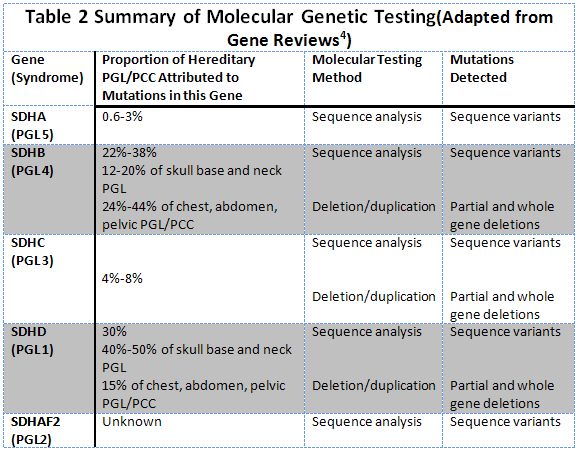Final Diagnosis -- Paraganglioma
FINAL DIAGNOSIS
Paraganglioma with one of eight (1/8) lymph nodes involved by metastatic paraganglioma
DISCUSSION
By convention, tumors in the adrenal gland are known as pheochromocytomas (PCC) and extra-adrenal tumors are termed paragangliomas (PGL). Paragangliomas are sub-categorized as sympathetic or parasympathetic neoplasms. The sympathetic paragangliomas secrete excess catecholamines that result in hypertension, sweating, palpitations, headaches, and apprehension or anxiety. The paragangliomas that are classified as parasympathetic are most often non-secretory. Approximately 30% of pheochromocytomas and paraganglionoma occur in the context of a germline RET, Von Hippel-Lindau, neurofibromatosis type 1, and succinate dehydrogenase (SDH) mutations. Distinguishing clinical features of each gene mutation can be found in Table 1.

Neoplasms arising from genetic alterations of the SDH gene are categorized by the mutations in the four subunits of the mitochondrial enzyme succinate dehydrogenase: SDHA, SDHB, SDHC, and SDHD. Each gene is associated with an individual hereditary paraganglioma/pheochromocytoma syndrome identified as: PGL 1 (SDHD), PGL 2 (SDHAF2, sometimes referred to as SDH5), PGL 3 (SDHC), PGL 4 (SDHB), and PGL 5 (SDHA). Table 2 provides a summary of molecular genetic testing used in Hereditary PGL/PCC syndromes.

After further testing, this patient was found to have a mutation in the SDH gene with a B subunit mutation (SDHB). The SDHB mutation is an autosomal dominant mutation with approximately one-third of the patients having a family history. They are associated with extra-adrenal sympathetic paragangliomas. The risk of malignancy is 34-97% and is the highest among the SDH mutations. Treatment should include prompt resection of the neoplasm to remove excess catecholamine secretion and as a result of their tendency to metastasize.
REFERENCES
- Chetty R. Familial paraganglioma syndromes. J Clin Pathol 2010;63: 488-491.
- McNicol AM. Update on tumours of the adrenal cortex, phaeochromocytoma and extra-adrenal paraganglioma. Histopathology 2011;58: 155-168.
- Gill A, Benn D, Choua A, Clarkson A, Muljono A, Meyer-Rochow G, Richardson AL, Sidhu SB, Robinson BG, Clifton-Bligh RJ. Immunohistochemistry for SDHB triages genetic testing of SDHB, SDHC, and SDHD in paraganglioma-pheochromocytoma syndromes. Human Pathology 2010;41: 805-814.
- Pagon RA, Bird TD, Dolan CR, et al. editors. GeneReviews [Internet]. Seattle (WA): University of Washington, Seattle; 1993-.
- Abermil N, Guillaud-Bataille M, Burnichon N, Venisse A, Manivet P, Guignat L, Drui D, Chupin M,
- Josseaume C, Affres H, Plouin PF, Bertherat J, Jeunemaitre X, Gimenez-Roqueplo AP. TMEM127 screening in a large cohort of patients with pheochromocytoma and/or paraganglioma. J Clin Endocrinol Metab. 2012;97:E805-9.
- Algeciras-Schimnich A, Preissner CM, Young WF, Singh RJ, Grebe SKG. Plasma chromogranin A or urine fractionated metanephrines follow-up testing improves the diagnostic accuracy of plasma fractionated metanephrines for pheochromocytoma. J Clin Endocrinol Metab. 2008;93:91-5.
- Amar L, Baudin E, Burnichon N, Peyrard S, Silvera S, Bertherat J, Bertagna X, Schlumberger M, Jeunemaitre X, Gimenez-Roqueplo A-P, Plounin P-F. Succinate dehydrogenase B gene mutations predict survival in patients with malignant pheochromocytomas or paragangliomas. J Clin Endocrinol Metab. 2007;92:3822-8.
- Amar L, Bertherat J, Baudin E, Ajzenberg C, Bressac-de Paillerets B, Chabre O, Chamontin B, Delemer B, Giraud S, Murat A, Niccoli-Sire P, Richard S, Rohmer V, Sadoul JL, Strompf L, Schlumberger M, Bertagna X, Plouin PF, Jeunemaitre X, Gimenez-Roqueplo AP. Genetic testing in pheochromocytoma and functional paraganglioma. J Clin Oncol. 2005;23:8812-8.
- Astrom K, Cohen JE, Willett-Brozick JE, Aston CE, Baysal BE. Altitude is a phenotypic modifier in hereditary paraganglioma type 1: evidence for an oxygen-sensing defect. Hum Genet. 2003;113:228-37.
- Astuti D, Latif F, Dallol A, Dahia PL, Douglas F, George E, Sköldberg F, Husebye ES, Eng C, Maher ER. Gene mutations in the succinate dehydrogenase subunit SDHB cause susceptibility to familial pheochromocytoma and to familial paraganglioma. Am J Hum Genet. 2001;69:49-54.
- Astuti D, Ricketts CJ, Chowdhury R, McDonough MA, Gentle D, Kirby G, Schlisio S, Kenchappa RS, Carter BD, Kaelin WG, Ratcliffe PJ, Schofield CJ, Latif F, Maher ER. Mutation analysis of HIF prolyl hydroxylases (PHD/EGLN) in individuals with features of phaeochromocytoma and renal cell carcinoma susceptibility. Endocr Relat Cancer. 2010;18:73-83.
- Badenhop RF, Jansen JC, Fagan PA, Lord RS, Wang ZG, Foster WJ, Schofield PR. The prevalence of SDHB, SDHC, and SDHD mutations in patients with head and neck paraganglioma and association of mutations with clinical features. J Med Genet. 2004;41.
- Bausch B, Borozdin W, Mautner VF, Hoffmann MM, Boehm D, Robledo M, Cascon A, Harenberg T, Schiavi F, Pawlu C, Peczkowska M, Letizia C, Calvieri S, Arnaldi G, Klingenberg-Noftz RD, Reisch N, Fassina A, Brunaud L, Walter MA, Mannelli M, MacGregor G, Palazzo FF, Barontini M, Walz MK, Kremens B, Brabant G, Pfäffle R, Koschker AC, Lohoefner F, Mohaupt M, Gimm O, Jarzab B, McWhinney SR, Opocher G, Januszewicz A, Kohlhase J, Eng C, Neumann HP. European-American Phaeochromocytoma Registry Study Group; Germline NF1 mutational spectra and loss-of-heterozygosity analyses in patients with pheochromocytoma and neurofibromatosis type 1. J Clin Endocrinol Metab. 2007;92:2784-92.
- Bayley JP, Kunst HP, Cascon A, Sampietro ML, Gaal J, Korpershoek E, Hinojar-Gutierrez A, Timmers HJ, Hoefsloot LH, Hermsen MA, Suarez C, Hussain AK, Vriends AH, Hes FJ, Jansen JC, Tops CM, Corssmit EP, de Knijff P, Lenders JW, Cremers CW, Devilee P, Dinjens WN, de Krijger RR, Robledo M. SDHAF2 mutations in familial and sporadic paraganglioma and phaeochromocytoma. Lancet Oncol. 2010;11:366-72.
- Benn DE, Gimenez-Roqueplo AP, Reilly JR, Bertherat J, Byth K, Croxson M, Dahia PL, Elston M, Gimm O, Henley D, Herman P, Murday V, Niccoli-Sire P, Pasieka JL, Rohmer V, Tucker K, Jeunemaitre X, Marsh DJ, Plouin PF, Robinson BG. Clinical presentation and penetrance of pheochromocytoma/paraganglioma syndromes. J Clin Endocrinol Metab. 2006;91:827-36.
 Contributed by Waseem Anani, MD and Anil Parwani, MD, PhD
Contributed by Waseem Anani, MD and Anil Parwani, MD, PhD







![]() Contributed by Waseem Anani, MD and Anil Parwani, MD, PhD
Contributed by Waseem Anani, MD and Anil Parwani, MD, PhD